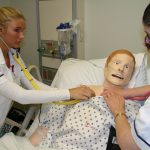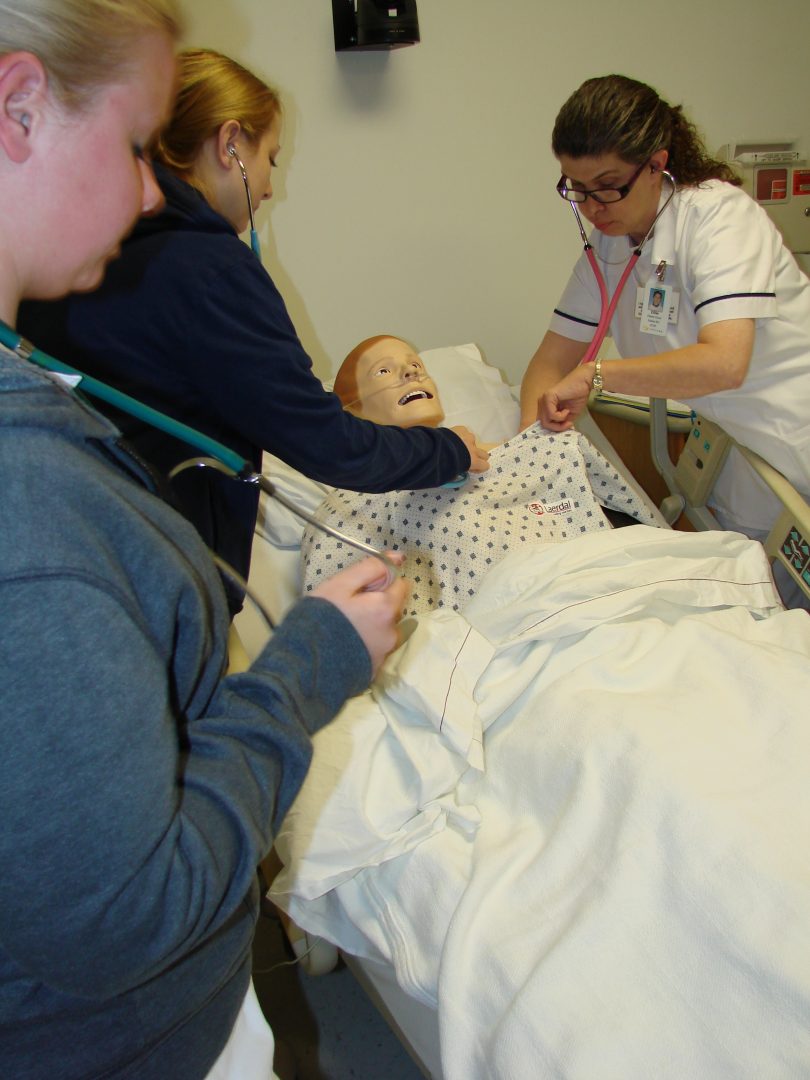Simulation Lab keeps students on their toes, provides high-fidelity learning in Chesapeake
Considering the circumstances, Mr. Shapiro looked OK: His chest was rising and falling regularly, his eyes blinking normally, and his skin sweat-free. In fact, he looked calmer than the nursing students. The group of 10 was quiet, and the four who would care for Mr. Shapiro looked at their feet or bit their lip.
Diagnosis: Nerves.
Most hadn’t been in the room before — which wasn’t really in a hospital but a simulated skills lab. They suspected that Professor Thompson would throw curve balls their way: She could manipulate “Mr. Shapiro,” a high-fidelity programmable mannequin who can cry, sweat, breathe rapidly and develop symptoms of cardiac arrest.
“I can do just about anything [with the help of three computers],” said Professor Thompson, “but make him move.”
While other local colleges also require students to practice in simulated labs, Thompson feels that Sentara’s is ideal: Unlike the others, the lab, with six mannequins available, is located in the same building as their classes, and only a handful of students work in each lab. Most have at least eight lab visits during their course work.
“Its size and location make it more personal, a little less intimidating, and more convenient,” said Thompson.
After she took a seat in the hallway, students Chelsea Haskins, Lyndsay Campbell, April Everett and Ellie Krom got to work. Hesitantly, like a team who had memorized the playbook but hadn’t yet won a game, they inched their way to the goal: a comfortable, comforted patient. They checked Mr. Shapiro’s name and birthdate on his wrist band; asked if he felt any pain; checked his blood pressure; listened to his heart, lungs, and stomach; and checked his pulse in his feet.
“I’m getting that pain in my chest again,” said Mr. Shapiro (really Professor Thompson) as they finished the exam.
After conferring, the team gave him nitroglycerin, explaining that they could repeat the dosage if he didn’t feel better in 5 or 10 minutes.
“How’s the pain now?,” asked Ellie after two.
Mr. Shapiro said he was still in pain, so the students gave him another pill under his tongue. But they were still concerned: His heart rate was up.
Quiet confusion took over the room: Was the pill making his heart faster or was something else? Should they give him another pill or was morphine a better idea? Or both? Where was the morphine? Should they start saline?
“The pain’s getting worse,” said Mr. Shapiro.
A bystander wasn’t sure what was happening: How many pills had been given? How much morphine?
“We’re supposed to be saying what we’re doing,” one of the students reminded the team.
“Help me think here, girls,” said Ellie.
They decided to call a doctor.
“Give him the facts,” Thompson offered. “Don’t interpret them.”
The professor was pleased.
“Whenever you are uncomfortable managing a patient, you should get more help. Remember, you are never alone,” she reminded. “With what you’ve learned in class, you’re doing exactly as I thought you would.”
Instead of smiling in relief, the students kept their game faces on – ready for the next play.
 Mr. Shapiro resting before a visit from his student nurses.
Mr. Shapiro resting before a visit from his student nurses.
Lyndsay Campbell listens to Mr. Shapiro’s heart as Chelsea Haskins checks his stomach and Ellie Krom asks a few questions.
The team works together to check Mr. Shapiro’s back: From left, Chelsea Haskins, April Everett, Lyndsay Campbell and Ellie Krom.
April Everett looks on as Lyndsay Campbell and Ellie Krom tend to Mr. Shapiro.
 Chelsea Haskins and Ellie Krom listen to Mr. Shapiro’s heart and lungs.
Chelsea Haskins and Ellie Krom listen to Mr. Shapiro’s heart and lungs.




